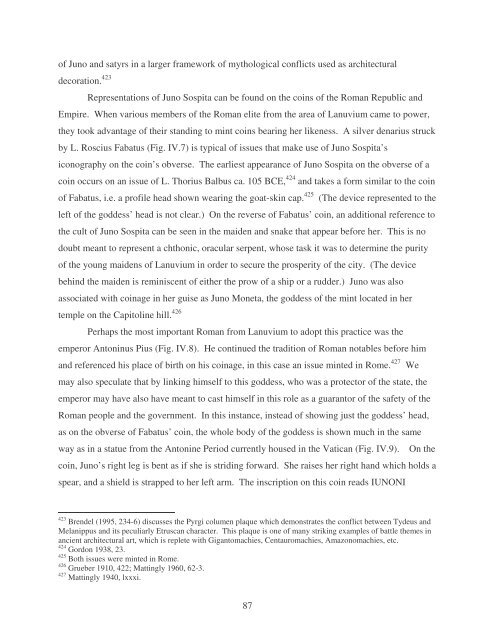Final Draft - Preview Matter - Florida State University
Final Draft - Preview Matter - Florida State University
Final Draft - Preview Matter - Florida State University
Create successful ePaper yourself
Turn your PDF publications into a flip-book with our unique Google optimized e-Paper software.
of Juno and satyrs in a larger framework of mythological conflicts used as architectural<br />
decoration. 423<br />
Representations of Juno Sospita can be found on the coins of the Roman Republic and<br />
Empire. When various members of the Roman elite from the area of Lanuvium came to power,<br />
they took advantage of their standing to mint coins bearing her likeness. A silver denarius struck<br />
by L. Roscius Fabatus (Fig. IV.7) is typical of issues that make use of Juno Sospita’s<br />
iconography on the coin’s obverse. The earliest appearance of Juno Sospita on the obverse of a<br />
coin occurs on an issue of L. Thorius Balbus ca. 105 BCE, 424 and takes a form similar to the coin<br />
of Fabatus, i.e. a profile head shown wearing the goat-skin cap. 425 (The device represented to the<br />
left of the goddess’ head is not clear.) On the reverse of Fabatus’ coin, an additional reference to<br />
the cult of Juno Sospita can be seen in the maiden and snake that appear before her. This is no<br />
doubt meant to represent a chthonic, oracular serpent, whose task it was to determine the purity<br />
of the young maidens of Lanuvium in order to secure the prosperity of the city. (The device<br />
behind the maiden is reminiscent of either the prow of a ship or a rudder.) Juno was also<br />
associated with coinage in her guise as Juno Moneta, the goddess of the mint located in her<br />
temple on the Capitoline hill. 426<br />
Perhaps the most important Roman from Lanuvium to adopt this practice was the<br />
emperor Antoninus Pius (Fig. IV.8). He continued the tradition of Roman notables before him<br />
and referenced his place of birth on his coinage, in this case an issue minted in Rome. 427 We<br />
may also speculate that by linking himself to this goddess, who was a protector of the state, the<br />
emperor may have also have meant to cast himself in this role as a guarantor of the safety of the<br />
Roman people and the government. In this instance, instead of showing just the goddess’ head,<br />
as on the obverse of Fabatus’ coin, the whole body of the goddess is shown much in the same<br />
way as in a statue from the Antonine Period currently housed in the Vatican (Fig. IV.9). On the<br />
coin, Juno’s right leg is bent as if she is striding forward. She raises her right hand which holds a<br />
spear, and a shield is strapped to her left arm. The inscription on this coin reads IUNONI<br />
423 Brendel (1995, 234-6) discusses the Pyrgi columen plaque which demonstrates the conflict between Tydeus and<br />
Melanippus and its peculiarly Etruscan character. This plaque is one of many striking examples of battle themes in<br />
ancient architectural art, which is replete with Gigantomachies, Centauromachies, Amazonomachies, etc.<br />
424 Gordon 1938, 23.<br />
425 Both issues were minted in Rome.<br />
426 Grueber 1910, 422; Mattingly 1960, 62-3.<br />
427 Mattingly 1940, lxxxi.<br />
87

















